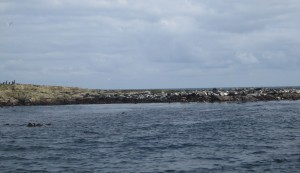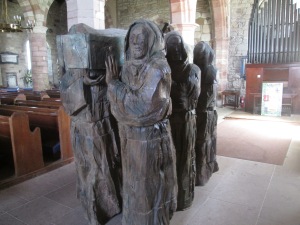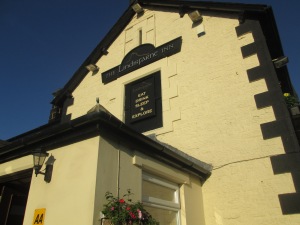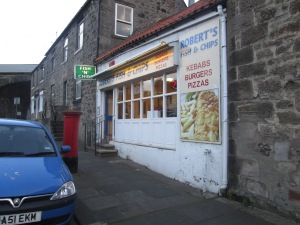‘You’re beautiful!’ – a woman to a man, supermarket, Berwick.
So, I bet you’re wondering whether the local Laird had me escorted off his castle grounds in the night?
Well… everything went quite fine, and I had a good night’s rest. I sneakily packed up my tent and things and cheekily went on my way, and took the road back towards the small harbour at Seahouses, grabbing some coffee and cake in Coxon’s café.
Travelling by bicycle is wonderful, but there are instances where alternative means are called for.
The Farne islands lie just a little off the coast by Seahouses. Once these rocky outgrowths were the death of countless fishermen and sailing boats, but today it is home to large sanctuary of unusual birds. The brave can take a boat and land on one of the islands though – be warned! – the Artic Terne who live here do enjoy nibbling human ears, and wearing a hat is essential. I’m not bothered about landing though, so I take the first boat trip that skirts about the islands. The trip is utterly extraordinary.
We huddle together on the boat as waves of surf fling themselves into the vessel. The sea rocks and bounces with a life of its own, and a language of its own. The skipper talks about ‘swell’, and criss-crosses the waters according to some esoteric route that best navigates the different channels of water. It’s another world of experience. To our left, small black puffins with yellow bills bob about in the waters as lairy seagulls lurk overhead. Locals call them tommy noddies, and there are 79 000 on the Farnes. They will lay a single egg and sit on it for 40 days with a fascinating maternal zeal, before moving on.
To our right on a distant rocky islet are large and sleek black birds, shags, stretching out their wings in the sun. They have no oil in their feathers and so have to dry out before re-entering the water, only half-adapted to their new environs. I look up and am astounded by the intelligence of the seagulls, capable of navigating wind channels with the bare minimum of wing movements. They oscillate up and down, pulled up by one wind and tugged down by another. Gannets, the largest of seabirds, have been seen near here, as have minke whales and bottle-nose dolphins. Nearby, razorbills and terne roam about in great swathes, their forms casting shadows across the morning sun.
We approach a large group of seals, some happily bobbling about in the water, others scratching themselves and yawning upon the rocks. In the water they are very friendly and can be stroked and tickled. It’s wonderful but sad to reckon with the fact that humans have exploited their puppy-like nature to kill them and use their bodies for fuel. They can live for 35 years, but are often abandoned by their mothers after 3 or 4 weeks after birth, with many dying.
Next, a series of stacks of rock where a great city of guillemots are clustered together. They are a little smaller than seagulls, and have a black head with a white body. The tang of their shit on the rocks reeks, and has turned the tops of the dark rocks into a deceptively chalky hue. They squawk to each other in an immense hubbub, and live in the same kind of proximity as Londoners on underground trains. They too have an unusual approach to child-rearing: when the young are ready to leave the nest, one parent will encourage it down towards the water, whilst the other parent will boot it off the rock. Kittiwakes hang out in similarly dense clusters too, wailing out with their distinctive cry. I realise I’ve seen them countless times before but never been able to distinguish them, as they look like half-sized seagulls.
Oh, the life of these birds!
Consider just how different their experience of the world is to ours. Their flight enhances physical space with an entirely new dimension of height. Air travel requires an unknown set of senses and navigatory skills that can anticipate and surf across different winds and air channels. They swoop down to earth for food, and at times for a rest, but rarely do they show any preference for ground living, with its predators and utterly limited, two-dimensional flatness. Up they go, playing and crying out to each other, flying from a predator, oblivious to our concerns. Their god has made the world for their use, just as the god of the fish has made the seas for them, and the god of men has used his intelligent design to fill the earth with sunlight and harvests. Chance and opportunity render life adaptable and preferable. I’d trade human life with that of a bird in a second. In the meantime, the closest thing to flight I have is the bicycle, where rarely do my feet ever touch the ground.
The rock of the little boat gets me thinking of my partner, who is easily sea-sick and wouldn’t be able to survive a trip like this without her stomach turning inside out. I miss her greatly. I have found that only throwing myself into conversations with strangers has distracted me from loneliness. Thinking of her reminds me of what love is, something that is simultaneously a physical and emotional connection wired to every impulse. That love brings life and warmth to the body, and hope to the mind. This kind of love permeates everything one does. At first it feels trepidatious and unsure, but once you take the risk and let it enter and overwhelm you, you’re transformed. I can’t quite put it any simpler terms. I’ll be seeing her in a couple of days in Edinburgh.
We pass one of the lighthouses that flickered over Bamburgh the previous night, and, on Inner Farne, an old looking building that once, in some previous guise, housed St. Cuthbert and St. Aidan, two medieval monks linked to nearby Holy Island at Lindisfarne. Cuthbert managed to escape the busy life of leading the monastery under the ruse of chasing away an evil demon here. His real purpose was escape, so that his ‘mind might be wholly bent on heavenly things’. In such remote and distant places, among great cold and little food, it is a wonder that individuals centuries ago managed to establish some kind of bond with the life of Jesus, a rebellious rabbi from Galilee whose life was neither ascetic nor isolated, and whose teachings were dedicated to the love of others.
We disembark and go separate ways. I take a new road inland, rolling through some more of the wonderful Northumberland countryside, up and down gentle hills in the early afternoon sun. The weather has been quite wonderful recently. As I pass through the countryside and coast, I can’t help comparing Northumbria to the relatively more popular and expensive Cornwall. The gentle sloping landscapes and pretty seasides with golden beaches immediately come to mind, and the terrain here is pocked with unusual birds and plants that make it feel quite unique and special. At the same time, there are very few stone circles or evidence of druids or pre-medieval paganism. It’s unlike say Norfolk too in that there are very few churches either all. Its history is told through its old castles and its border conflicts with the Scots to the north, and hark back to more ancient times. Were it not for the occasional car or caravan park, one could scarce tell it was the 21st (or 20th) century at all.
I hurry along north to Lindisfarne, Holy Island. Before visiting it is essential to check the tide times, as the island is inaccessible for about half the day, when seawater floods the causeway. I arrive with about an hour to look around before the sea sweeps me away. The road to the island itself is surprisingly long, but allows for vast and breathtaking views of the bay and coastline. The community here is very small, little more than a tiny village, and entering is a bit of an anti-climax. Past a car-park and little café, one is caught between a network of about three small lanes on which B&Bs and an abundance of tourists jostle between the island’s surviving heritage.
I visit the ancient priory here, little more than a picturesque ruin now maintained by English Heritage. A religious community was established here by Bishop Aidan nearly 1700 years ago, after he was summoned from a community of Irish monks in Iona by King Oswald of Northumbria to convert the many local heathens. Along with twelve monks, Aidan’s mission was a little like Cedd’s in Bradwell, Essex: he arrived among an extremely poor set of disparate rural communities, and quickly went about helping local people, preaching Christianity in a manner they could understand, and setting up a local school. Lindisfarne becomes a key outpost of English Christianity, yet it was characteristically Irish, practising and preaching an Irish form of Celtic Christianity at odds with the Roman Church.
There are some signs of this in the pretty abbey that survives. I wander around the grounds and dive into St. Mary’s church, a more recent creation that imposes a tranquil and meditative state on the solo visitor. There is a unique wood sculpture of some ill-looking monks carrying a coffin, and the simple stones and stained glass of the church is wonderful. Inside, I find out more about the island.
Cuthbert later became abbot here, performing miracles and further spreading Celtic Christianity. As with the ‘oldest pub in Britain’, I’ve heard several claims for the ‘oldest surviving English writing’, but one claim is that an anonymous biography of Cuthbert between 685 and 704 takes the mantle. Either way, one apparent sign of Cuthbert’s holiness was the discovery that, eleven years after his death, his body had not decomposed. The monks ‘found his body entire, as if it were still alive’, reports Bede. Under Aidan and Cuthbert, Lindisfarne became a major propagation point of Christianity. The earliest illuminated manuscript gospels in England were produced here back in 698, using red colour from insects of the Mediterranean, and blue lapis lazuli from the Himalayas, indicating the extent of trade even back then.
The decline of Celtic Christianity, and a brutal Viking invasion in 793, each contribute to the decline of Holy Island. Monks feared for further invasions and slayings, and eventually abandon the island altogether, taking Cuthbert’s intact body with them. Today on Lindisfarne there are many tourists, a few ruins and, in the distance, a postcard castle.
Here’s a riddle for you, taken from the 10th century Exeter book. Can you guess what it refers to?
‘An enemy ended my life, deprived me of my physical strength; Then he dipped me in water and drew me out again, and pit me in the sun where I soon shed all my hair. After that, the knife’s sharp edge bit into me and all my blemishes were scraped away; Fingers folded me and the bird’s feather moved over my brown surface, sprinkling meaningful marks; It swallowed more wood-dye and again travelled over me leaving black tracks. Then a man bound me, he stretched skin over me and adorned me with gold; Thus I am enriched by the wondrous work of smiths, wound about with shining metal.’*
Time is against me, and I’m anxious not to get stuck on this tiny island, so I pedal with some vigour over the long causeway, the glorious sun reflecting in the rising waters and dazzling my eyes. It’s been a wonderful trip, and I take refuge in the Lindisfarne Inn. Over the course of a couple of pints of Farne Island, I finish writing up a travel post and start to digest the experiences.
The writing on this journey does take some time, I must admit. I use the Evernote app on my phone to record conversations and observations over the course of a day. About a day or two later, I find time – usually in the morning or afternoon, between destinations – to start writing these up into a coherent narrative. It’s a struggle to piece it all together, and often takes some hours. But without these long and rambling posts I inflict upon you, my reader, I would struggle to recall where I’d been or what I’d heard.
It’s about 7pm when I head back on the road again, following the A1 north to Berwick. I have a theory with A-roads: the smaller the number, the more dangerous they are. This is true of the A1 further south, but this evening it is quite gentle, and I head down it with little disturbance, eventually reaching the outskirts of Berwick-upon-Tweed.
At some point along the road I must have surely entered Scotland, but why didn’t anyone tell me? As the road slides into Berwick, the architecture suddenly changes. Gone are all the jerry-built Victorian terraces and offensively cheap and thoughtless 1960s blocks. To my left and right are well-built and hardy houses of thick grey brick, emanating a dour pragmatism that responds to the more overcast skies. I pop into an Asda for some dinner ingredients and find the shelves stocked with Scottish cheese and beer. The cashier even sounds Scottish though, as I’ll find out, many people from Berwick have a kind of Scots accent.
I head further into the town, past classically unfussy chippies and pubs that pay no regard for attracting passing trade, before heading over a pretty bridge lines with poles. In the distance is a great viaduct which casts an impressive aura over the small buildings of the little town, and to my right, where the Tweed river enters the sea, is a small harbour and pier with a little lighthouse at the end.
Berwick seems like a nice place though one that’s also quite hard-up. There are few people milling about, and despite the brilliantly cheap prices of the pubs (£1 per shot of Sambuca, get in!) they’re not very busy, whilst the odd shop I pass is permanently closed. I pass through a couple of back-streets and reach an old Maltings building now converted into an art gallery and youth hostel. I thought I’d treat myself to a shower and bed on my last night in England, and at £15 it’s reasonable enough. I check-in and buy a beer and get my change with a cheery blue Scottish note. Caledonia, so near!
I’m tempted to pop into the nearby Barrels boozer, a locals favourite and one which promises all manner of odd characters, but I’ve fallen behind with my writing, and want to get my mind is clean as I can before crossing the border. I make an unreasonably huge feast of rice, kidney beans, halloumi and salad, and wash down the nutritious stodge with a couple of beers, before wringing my head of its impressions. England has inspired and worn me out.
Sitting in the reception, I’m easily distracted by loud European tourists tapping idly on video games on their tablets. One man yawns excessively loudly; another woman talks several decibels too loud to some suffering soul on the side. I’m weary yet restless. Man, I want to go out into the night, get myself drunk, wander lost around backstreets and gaze out at the night-time coast, but it’s not quite the time nor place. Tomorrow I will officially leave England and not return for many weeks. I clamber into my bunk and sit back, til the rhythmic snoring of German tourists gradually whisks me asleep.
* The answer? An illuminated manuscript, of course….!














































































